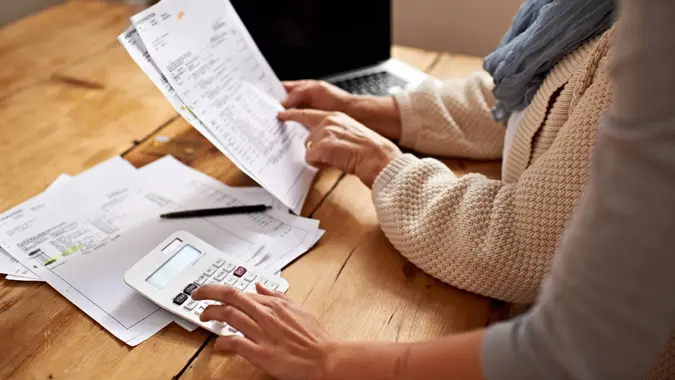Trump’s $2K Promise: What It Could Mean for Your 2026 Tax Return

Commitment to Our Readers
GOBankingRates' editorial team is committed to bringing you unbiased reviews and information. We use data-driven methodologies to evaluate financial products and services - our reviews and ratings are not influenced by advertisers. You can read more about our editorial guidelines and our products and services review methodology.

20 Years
Helping You Live Richer

Reviewed
by Experts

Trusted by
Millions of Readers
When the White House makes a promise about distributing benefits to Americans, it’s hard to remove politics from the equation, regardless of who is president. So when President Donald Trump recently promised a $2,000 “dividend” for most Americans, analysts and journalists immediately began parsing out exactly what that meant, and why he said it.
Although details are still sketchy, the $2,000 dividend could potentially affect your 2026 tax return in a number of different ways. Here’s a look at exactly what the president said, how the dividend may play out and what it could mean for your taxes.
What’s the Origin of the Dividend Promise?
Beginning on Nov. 9, President Trump made a series of posts on social media platform Truth Social regarding the dividend. Specifically, Trump declared, “People that are against Tariffs are FOOLS! We are now the Richest, Most Respected Country In the World, With Almost No Inflation, and A Record Stock Market Price. 401k’s are Highest EVER … A dividend of at least $2000 a person (not including high income people!) will be paid to everyone.”
What Are the Specifics?
While this might sound great on paper, Trump offered little by way of detail. As of Nov. 13, there still has been no clarification of who counts as “high income,” which Americans would qualify for this “dividend,” and how or when it would be paid.
Treasury Secretary Scott Bessent seemed to walk back the thought of distributing actual dividend checks when he told ABC News’ “This Week” that “It could be just the tax decreases that we are seeing on the president’s agenda. No tax on tips, no tax on overtime, no tax on Social Security, deductibility on auto loans. Those are substantial deductions that are being financed in the tax bill.”
According to ABC News, on Nov. 12, White House press secretary Karoline Leavitt told reporters at the White House, “The president made it clear he wants to make it happen. So his team of economic advisers are looking into it.”
Put it all together, and as of Nov. 13, it’s not at all clear how or even if the $2,000 dividend will come about.
Does the Math Work Out?
According a post from Erica York, vice president of federal tax policy at the Tax Foundation, handing out $2,000 cash to the bulk of the U.S. population could cost $300 billion or more — an amount that would exceed the net revenue brought in so far from Trump’s new tariffs. And it’s entirely possible that the tariffs could go away, or even be retroactively deemed illegal, by the Supreme Court of the United States, according to AP News.
This is likely the reason Bessent sidestepped the idea of actual dividend checks going to Americans. If the $2,000 is cloaked in other deductions or tax breaks as he suggested, the administration could likely sidestep cash payouts.
Assuming It Passes, What Could It Mean for Your Taxes?
If everything falls into place and Americans actually receive some form of $2,000 dividend, here are some of the ways it could play out for your taxes.
- If paid in the form of a “stimulus check,” like the ones issued during the pandemic, they will likely be nontaxable. This means your tax liability will not increase, and the money paid to you will not push you into a higher tax bracket.
- If issued as a tax credit, it will reduce your tax liability by the amount of the payout, potentially $2,000. If you don’t owe $2,000 in taxes, any excess amount would come in the form of a tax refund. This amount would also be nontaxable.
- If used as some type of deduction or exemption from taxes, whatever benefit you receive would also be nontaxable. For example, if the $2,000 comes in the form of an exemption from auto loan interest, it simply means you won’t have to pay as much on your car loan.
Overall, President Trump’s offer of a $2,000 dividend to low- and middle-income Americans certainly sounds attractive on the surface. But as of mid-November, there’s still no real clarity on where the money will come from, who it will go to or whether it will actually happen. The best course of action right now is to keep an eye on the news to see when — or if — the policy is actually implemented.
Editor’s note on political coverage: GOBankingRates is nonpartisan and strives to cover all aspects of the economy objectively and present balanced reports on politically focused finance stories. You can find more coverage of this topic on GOBankingRates.com.
More From GOBankingRates
 Written by
Written by  Edited by
Edited by 
























